Water is a poem written by prominent Dalit feminist writer and scholar Challapalli Swarupa Rani. The poem “Water” explores the theme of caste discrimination.
Summary of Water Poem 2nd Puc By Challapalli Swaroopa Rani
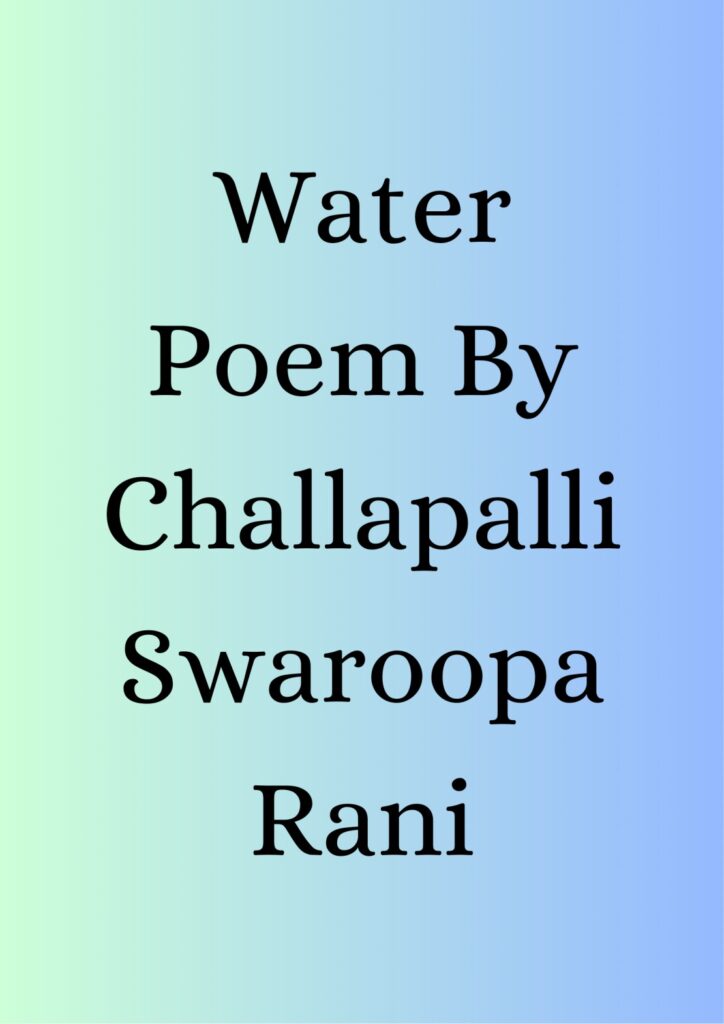
Summary of Water By Challapalli Swaroopa Rani
In the poem, the poetess has made water a witness and portrayed it as a person who has seen shameful things like caste discrimination.

Just as water naturally recognize the slope of the land, it is also well aware of the distance that has been created in society for generations – the distance that has stood as an invisible but solid wall between the main village and the Dalit settlements (wadas) within the same village.
Water touches everything, flows everywhere – but not everyone gets the right to touch it. This is the same water that is always wet on the walls of the well, but still, like that wetness, untouchability also never dries up. It remains continuously – it is not visible, but is felt.
These lines remind us that even if we talk of development or equality in society, but the moisture of caste discrimination still resides in every corner – like the wet walls of a well, which become wet again no matter how many times you dry it.
Water in the poem is not just an element, it is a witness – of the long social injustice that Dalits have suffered. It is as easy to understand for that water as it is to recognize the slope of the land, who is above and who is below in the society. And to know that untouchability is not a thing of the past, it still exists silently in the same way even today.

This sentence is not a mere statement, but an expression of a deep social consciousness. Water, which is itself pure and impartial, also recognises the walls erected by man. It knows how human beings have divided each other in the name of religion, race and caste.
For example, it knows that the woman of Samaria and Jesus, who were Jews, could not talk to each other – simply because their race and religion were different.
Water is a witness to that historical moment where religious differences hindered contact and equality. Then it knows that not only religion, but also sub-castes within caste separate human beings –
“leather” and “spool” – which are indicative of the discriminations that exist even within the Dalit community. The one who works with leather, and the one who weaves – both are Dalits, yet they are considered inferior or superior to each other. Water sees everything, understands everything. He knows that discrimination does not come from outside only, It also grows within – like the snake coming out of its burrow.
Summary of meaning:
In this Stanza of poem, poet is trying to tell us that even though water touches everyone equally but humans divide it in discrimination. It highlights not only religious or caste differences, but also the subtle differences within them – which are usually overlooked.
It shows that even a fair thing like water feels the cracks in human society – it is a witness to these depths.
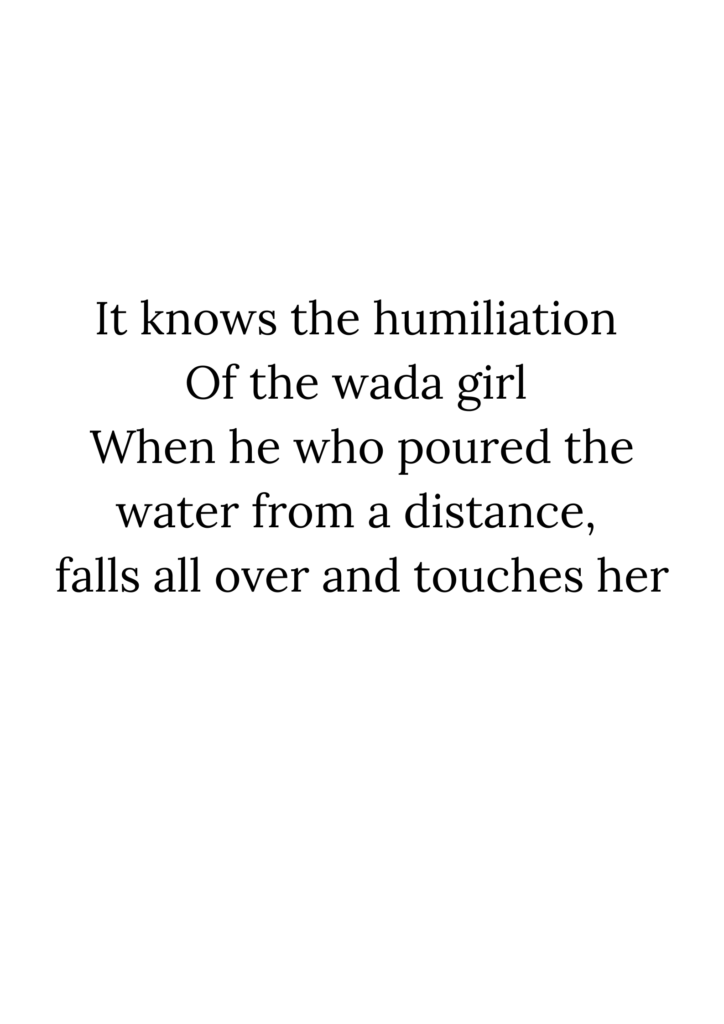
Water knows the humiliation that the girl from the wada (Dalit colony) suffered. The girl who begs for water every day to quench her thirst, Who is not allowed to fill water from the tap or the pitcher. That water is also given to her as if touching an untouchable even a shadow would corrupt her religion —
A man from a higher caste pours water from a distance, just so that she ‘does not touch’. But look at the irony — the same man himself slips and falls one day and touches the same girl. Now what happens? Has his religion ended? Has he also become impure now?
Water knows all this — it knows how hollow this society’s definition of purity is. And it knows how much humiliation is hidden in that one touch — Because that girl, who is a human being, has never been considered a human being. For him, touch became an insult, because society had taught him that “touching you is a sin, and being touched by you is impurity”.
Summary of the meaning:
Water is a silent witness to the insult of the girl – who has been made to live as if she is against purity. He knows that this insult does not happen just once, it is repeated every day – every time water is thrown at him from a distance, every time he is not treated like a human being.
And finally, when the same human accidentally touches it – The water reveals the truth, That it is not impurity, but the degradation of social thinking.

Water knows the ‘burning anger’ that burned inside Suvarthamma of Karamchedu — when the Kamma landlords humiliated her just because she was a Dalit woman and dared to draw water from the village pond. “You will pollute our water!” — just by saying this, they tried to erase her existence. But that day Suvarthamma did not bow down. She made the water pot in her hand a weapon. She did not keep quiet, she became the first woman to resist with water.
Water, which was till now a witness to humiliation — became a tool of rebellion that day. Historical background: This stanza is related to the background of Karamchedu massacre (1985, Andhra Pradesh), where the Kamma landlords committed inhuman atrocities on the Dalits — just because a Dalit woman dared to draw water from the pond. Suvarthamma was the spark in the fire of injustice, which made this incident a symbol of the Dalit movement.
Summary of Meaning :
Water knows when humiliation crosses the limit and resistance is born. It knows that the right to water is not just a question of purity or religion, but a question of human dignity. When a woman, who was silent for centuries, turns her water pot into a weapon, then that water becomes a symbol of revolution. Water – witness and warning:
Water does not just flow in this stanza, it watches. It has been watching for centuries: The tears that fell silently, The pitchers that were returned half-filled, The girls who heard abuses at the well, And the women who fought just for the right to drink. Water not only gives life, It is a living document of centuries of injustice.
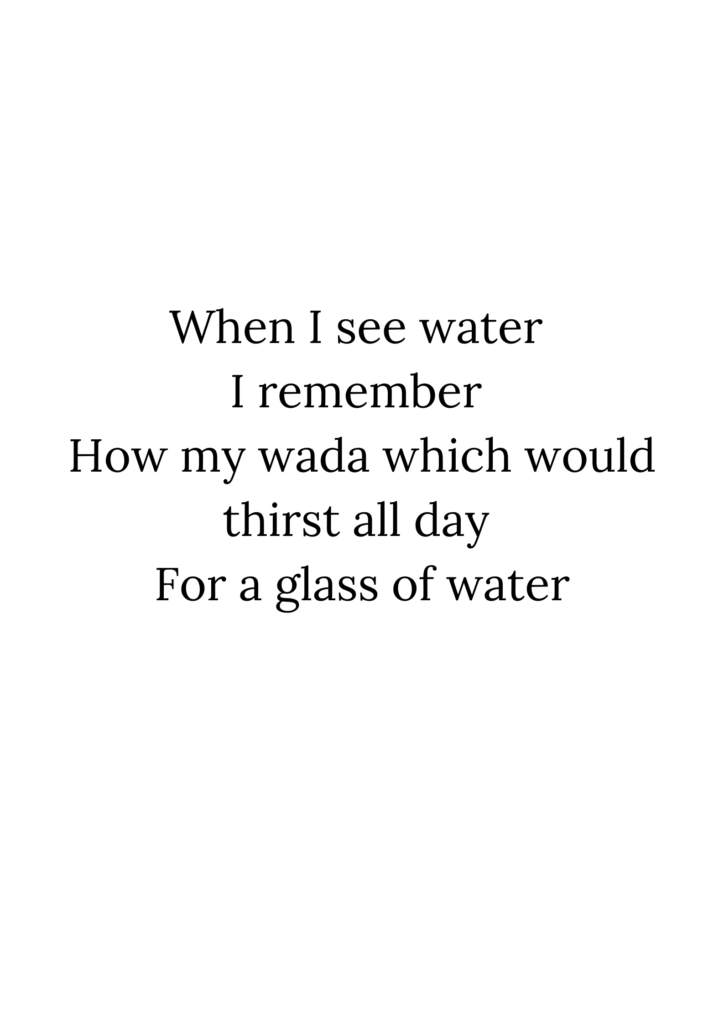
The poet says whenever I see water, It is not just a liquid for me . It starts flowing like a whole river of memories. I remember the village where I grew up – Where the land was dry, but the condition of the people there was even more dry. Even after a hard day’s work, We used to yearn for a glass of water. That village where thirst was not just in the throat –
It was in the soul, within the system. Where from morning to evening, children, women, old people. Everyone asked for water with their eyes. Because they were not allowed to extend their hands.
It was not just thirst. It was the thirst of that colony, Where water became impure even by touching it. Where there were taps, there were ponds, But there was no right over water. Water was not kept away from our doorstep,
From our existence.
Why are these lines important?
This stanza talks about social discrimination and water rights.
It is a glimpse of the experiences of injustice seen through the eyes of a Dalit woman.
In it, “water” becomes a symbol – of a basic human right that is taken away from a community just on the basis of their birth.
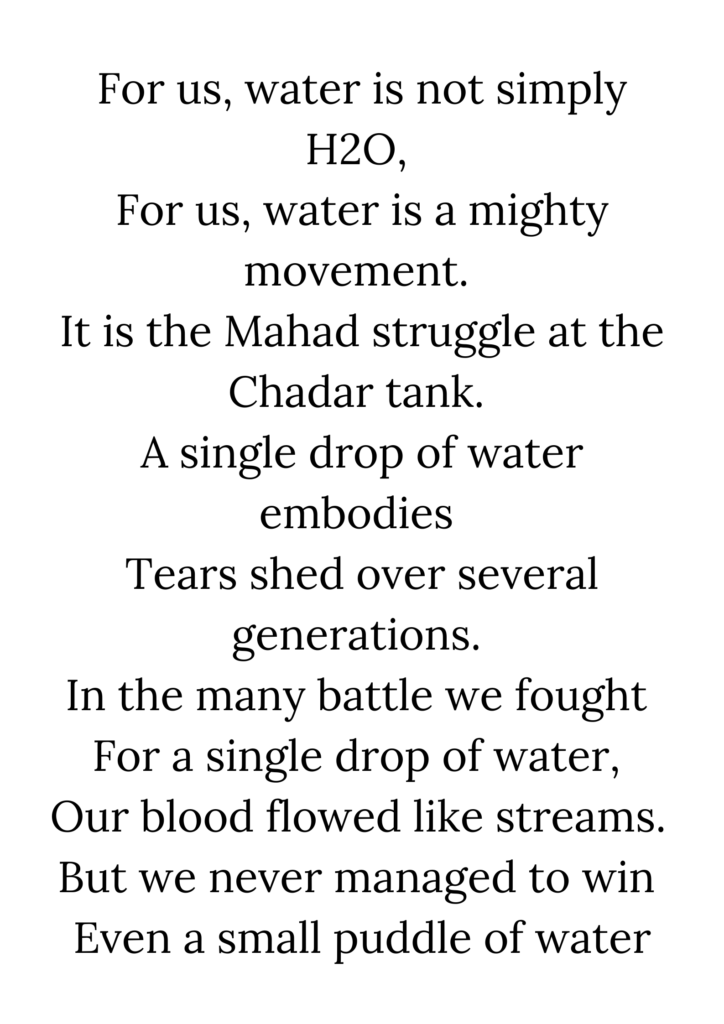
For us, water is not just H₂O — it is much more than two hydrogens and one oxygen. For us, water is a movement, it is not an ocean, it is history. It is the echo of the Mahad struggle, the day when Dr. Bhimrao Ambedkar challenged the wells and ponds of untouchability. The Chavdar pond of Mahad — where there was water, but not for us.
The water that belonged to everyone, yet was far from us. Water — one drop, tears of many generations: One drop of water for us is not just satisfaction, but the collected pain of tears of thousands of eyes. Every drop contains the helplessness of a mother, the thirst of a child, the broken hope of an old man.
For that one drop. We fought for centuries, Our blood flowed like streams, But in return we did not get even a small pit full of water. This fight was not for water. The fight was not just for water, It was a fight for respect, equality and rights. When society decided who can touch water and who cannot —Then water became a symbol of power from a life-giving commodity.
Summary of the meaning :
This stanza tells that for the Dalit community water is not just a necessity. It has become a symbol of both deprivation and rebellion. The Mahad struggle (1927) is not just a historical event, It still burns in the soul of every person, Who was once left thirsty just because of caste.
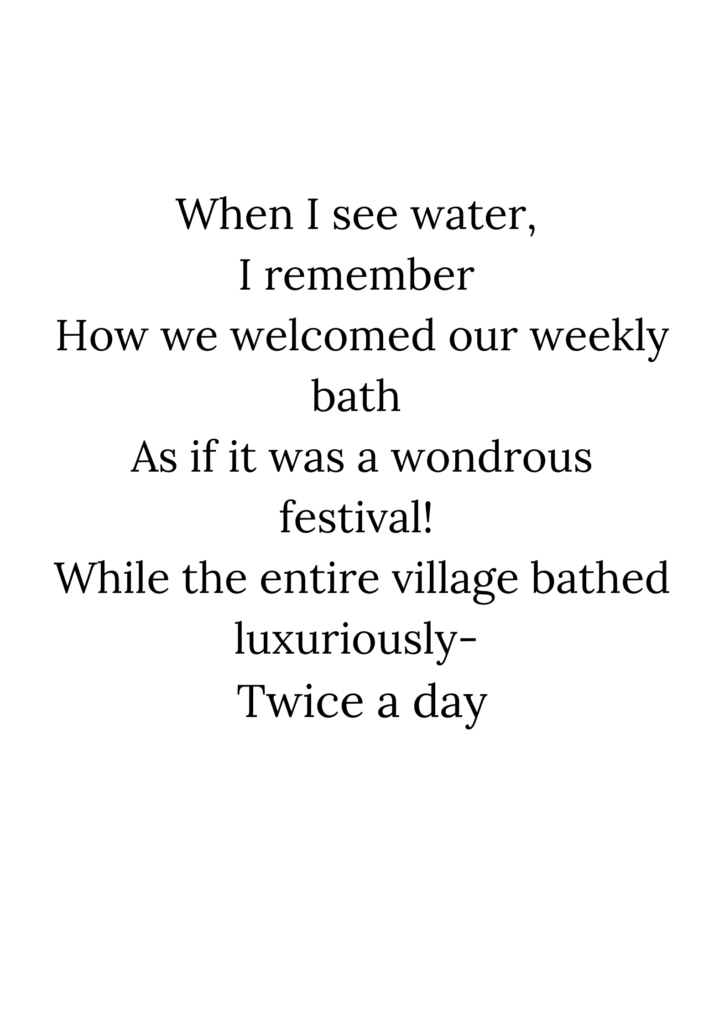
Whenever I look at water, I remember the one day, when we were able to bathe after waiting for a whole week. That day became a festival – changing clothes, washing hair, and feeling human for a little while.
For us, bathing once a week was not a normal thing. it was a special occasion, like a poor child getting sweets for the first time. But at the same time, in the upper houses of the village, people bathed twice a day –like it was their birthright.
Why like a festival?
Because we didn’t just wash off the dirt from our bodies, we also tried to remove layers of caste-based humiliation on that day. A day when we felt “equal, not different” for a little while. That little use of water was a drop of respect.
Water – Not Just Bathing, It Was Self-Respect: Those who had taps running all the time in their homes never understood what it was like to not have water. For those for whom bathing was a routine, it was a rare experience for us. When water is not available, even “being clean” becomes a dream.
Summary of the meaning :
Through this stanza, the poetess reminds us that the things that we consider “common” are still rare for many. When bathing becomes a festival, then understand – this society is not equal for everyone.
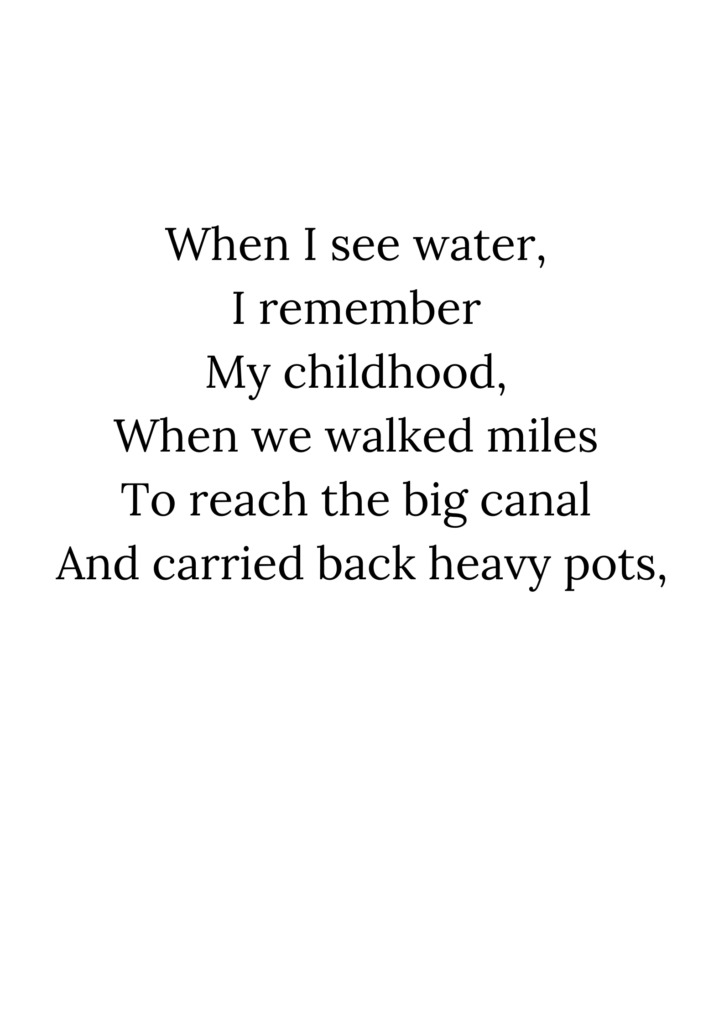
When I see water today — flowing from a tap, stored in a tank, or bottled — the paths of my childhood emerge before my eyes. That childhood, where we had to walk miles to get water. Ground burning in summer, feet burning in the sun, pots on the shoulders — and mothers, sisters, neighbors and fatigue.
We all walked towards a big canal, from where we got water — not for free, not easily — but at a heavy price of sweat and patience. Fetching water — the biggest task of childhood.
At an age when children play after school, we were learning to balance water pots. For us, it was not a game, but the journey to the well was life. Fetching water was not a “festival” in our house, but a part of our daily exhaustion and struggle.
Summary of the Meaning :
This stanza does not just talk about geographical distance, but presents a picture of that period of social distance and deprivation, when even water had become not just a convenience but an object of power and labour. It tells how an entire childhood can be spent only in search of water, and yet remain deprived of respect.
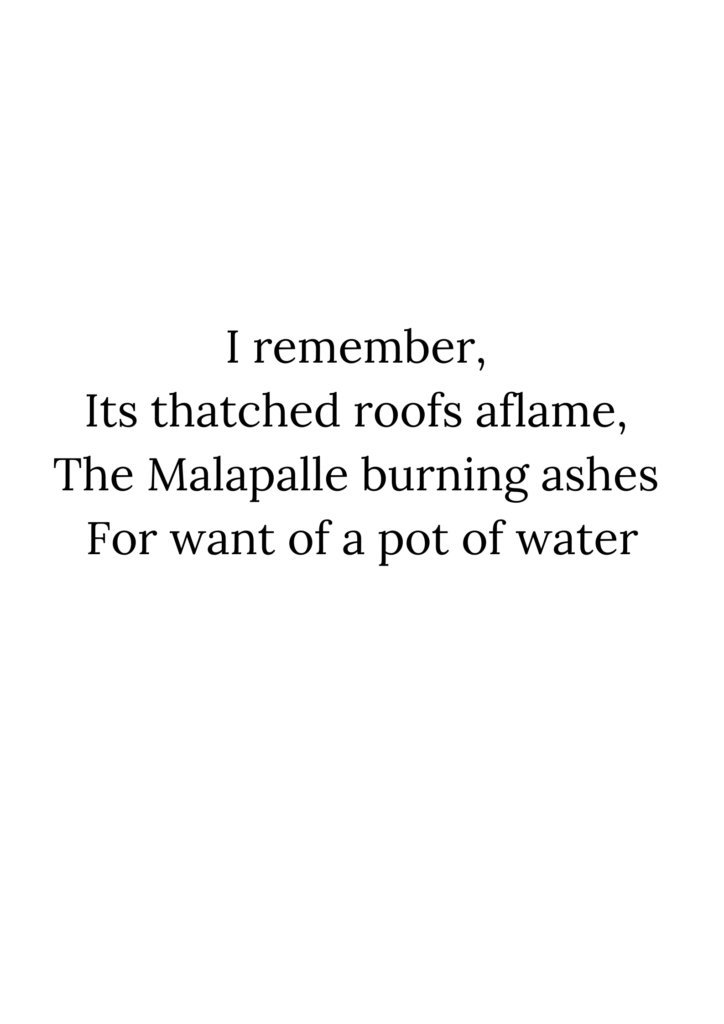
The poet says I still remember the scene, where the thatched huts of Malapalle (a Dalit colony) were burning in fire. There was no storm, no lightning struck – yet the whole village was burning, just for a pot of water.
Malapalle’s fire – not just a burning, it was a punishment: This fire was not natural, it was man-made fire of hatred and untouchability. When a community is denied access to water, and demands its rights, they often get fire in response. Here a colony paid the price of not getting water with its homes, and their dreams, respect and support turned to ashes.
Water – not a necessity, it became a reason for punishment:
A pot of water which was a normal thing for someone,
became a reason for dispute for Malapalle,
and finally an excuse for punishment.
Their huts were burnt because they gave voice to thirst.
Summary of the meaning :
This stanza highlights that the Dalit communities in India have had to struggle not just for water but also face humiliation and violence. Water here is not just a liquid, it is a spark that has been burning even in the lowest layers of history.